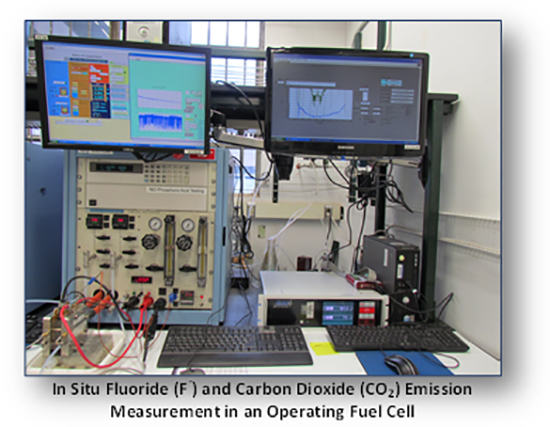| Laboratory: | Los Alamos National Laboratory (LANL) |
| Capability Expert(s): | Hoon Chung and Piotr Zelenay |
| Capability Details: | |
| Title: | In situ fluoride and carbon dioxide emission measurements |
| Class: | Characterization & Testing |
| Description: |
Characterization of fluoride (F–) and carbon dioxide (CO2) emissions in the exhaust from operating polymer electrolyte fuel cells (PEFCs) are crucial to determining the rates of membrane and ionomer degradation, as well as the rates of carbon corrosion in PGM-free catalysts. Most active PGM-free catalysts contain small amounts of transition metals, typically at less than 2 wt%. Transition metal ions, e.g., Fe2+, act as a Fenton reagent in the presence of H2O2 (Fe2+ + H2O2 → Fe3+ + OH– + OH˙; Fe2+ + H2O2 → Fe3+ + H+ + OOH˙), producing harmful hydroperoxyl radicals (OOH˙) as a result. These radicals cause degradation of Nafion® membrane and ionomer, producing F– as the main byproduct. By measuring the amount of emitted F–, the extent of the membrane and ionomer degradation can be calculated. Furthermore, carbon corrosion is thought to be one of the leading causes of the decrease in the ORR activity of PGM-free catalysts due to the destruction of oxygen reduction active sites. Thus, detection of the amount of CO2 generated during PGM-free catalyst corrosion can provide important information on the catalyst degradation mechanism. Parallel measurements of fluoride and CO2 emissions at various fuel cell operating conditions, e.g., under varied voltage, relative humidity, and temperature, provide essential data that can be later used for the purpose of improving the durability of PGM-free catalysts. In situ F– and CO2 detection systems are not commercially available. Therefore, LANL has developed a system to simultaneously measure both F– and CO2 emissions during fuel cell operation. The dehumidified gas is passed to a non-dispersive infrared (NDIR) detector to measure the amount of CO2. Water is removed from the cathode exhaust by a combination of heat exchange and desiccation to avoid interference with the CO2 measurements. The fluoride concentration is measured in the collected water using ion chromatography. |
| Capability Bounds: | There are no technical limitations to current in situ measurements of F– and CO2 emissions with this system. |
| Unique Aspects: | This system has been developed by LANL and is unique to the LANL fuel cell program. |
| Availability: | The equipment is fully available to ElectroCat. |
| References: |
P. Zelenay, “Non-Precious Metal Fuel Cell Cathodes: Catalyst Development and Electrode Structure Design,” Hydrogen and Fuel Cells Program 2016 Annual Merit Review and Peer Evaluation Meeting, Washington, DC, June, 2016. Hoon T. Chung et al., “Fuel Cell Performance of (Cyanamide + Polyaniline) – Iron-Carbon Cathode Catalyst,” 229th ECS Meeting, San Diego, CA; May, 2016. |
| Benefit: | An understanding of possible catalyst, ionomer, and membrane degradation mechanisms via simultaneous measurements of F– and CO2 emissions is essential for the further development of PGM-free catalysts and electrode structures. |

